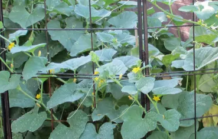So, what can I still plant in my garden? We’re still in the beginning stages of the vegetable garden season. Now its time to plant the next round of garden produce to keep the harvest growing!
What can you plant after the cool season vegetables are winding down? Warm season produce is next. You can still plant cucumber, melons, peppers, pumpkin, squash, sweet corn, sweet potato, tomato, tomato and watermelon. Lots of things can still be planted!
Cucumber Cucumbers are warm-season crops that traditionally have required a lot of garden space. With a trellis or newer compact varieties, cucumbers may be grown in small spaces and even in containers. An increasing diversity of cucumber types are available to a home gardener. Some types of cucumbers are best grown in a greenhouse or high tunnel, but many will grow well in a regular garden.
• Pickling. These varieties are short and blocky in shape, with a firm flesh that makes a crisp pickle. They frequently have very prickly skin.
• Slicing. Slicing cucumbers are long and slender, with a dark-green skin. They are usually not as prickly as pickling cucumbers.
• Asian cucumbers. These cucumbers are also long and slender with relatively thin skin but can have prickles. They have been bred to be both burpless and bitter-free.
• English or greenhouse. English cucumbers are very long with very thin, tender skins. They are usually grown in a greenhouse and may not be as heat tolerant.
Variety considerations. There are many types of cucumbers with range of plant characteristics to consider when selecting varieties. There are certain varieties that have a more bush-type growth habit and would not need trellising. The majority of cucumbers will need some sort of trellis or lots of space to grow.
Be aware that some heirloom and older hybrid varieties can be more susceptible to developing bitterness during the heat of summer or due to other stress on the plants. Look for varieties that are bitter-free for best eating qualities during a hot summer. Choose varieties that are resistant to powdery mildew and other diseases.
If planting cucumbers for a fall crop or for early season harvest in June, be sure to look for varieties that have fewer days to maturity. It may also be helpful to look for types that are more likely to perform well under cooler conditions.
When to plant. Cucumbers require warm conditions with no danger of frost for best results. Soil temperatures should be approaching 60°F, which occurs in early May in most of Kansas. Using black plastic mulch to warm soil is a way of producing cucumbers earlier.
Spacing. Cucumbers are usually spaced 2 feet apart in rows 5 to 6 feet apart. However, bush types may be spaced 2 feet apart in rows 3 feet apart. If planting on a trellis, space plants about 2 feet apart along the trellis.
Crop rotation. If possible in your garden space, do not plant cucumbers in an area where melons, squashes, pumpkins or cucumbers have been planted in the past 3 to 4 years.
Care. Cucumbers may be transplanted by starting seeds in large containers and moving them carefully to the garden area, taking care not to disturb the roots. Do not let transplants get larger than one or two sets of true leaves or start to vine before planting.
Cucumbers are fairly shallow-rooted and require caution at initial cultivation. One application of fertilizer along the row when the vines are 6 to 12 inches long will improve production into the bearing season. Cucumbers can be grown on a trellis or cage, but you may have to help the vines get started up the trellis.
Avoid areas where strong winds may damage vines on the trellis. Cucumbers have separate male and female flowers on the same plant. Male flowers predominate and usually appear before female flowers start to develop. Many newer cucumber varieties are of the gynoecious type or have a larger number of female flowers for higher yields. Bees are required to transfer pollen from male to female flowers for the fruit to develop.
Harvesting. Select firm, dark-colored cucumbers developed before the seeds have a hard seed coat and while the skin is tender. Small cucumbers may be harvested for pickles at any stage. Removing large, overgrown fruits will keep vines productive longer.





